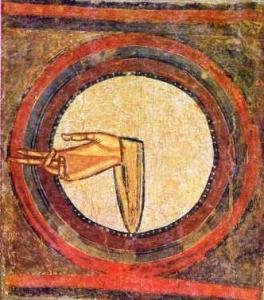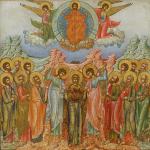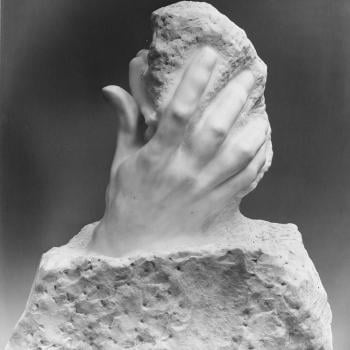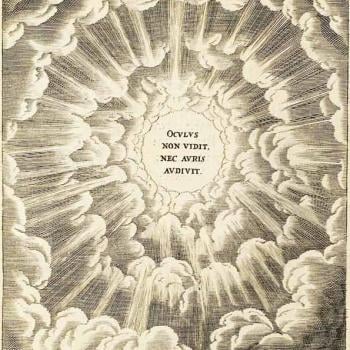 After mentioning his Theological Outlines and his Divine Names, presenting the names and titles given to the person of the Trinity and the Godhead as a whole, Dionysius mentioned his Symbolic Theology and how he explored the various metaphors which could be used to describe the activity of God in creation. As with the Divine Names, divine revelation served as the foundation for his theological reflection. In explaining what he thought was important in the Symbolic Theology, he wrote:
After mentioning his Theological Outlines and his Divine Names, presenting the names and titles given to the person of the Trinity and the Godhead as a whole, Dionysius mentioned his Symbolic Theology and how he explored the various metaphors which could be used to describe the activity of God in creation. As with the Divine Names, divine revelation served as the foundation for his theological reflection. In explaining what he thought was important in the Symbolic Theology, he wrote:
Further, in the Symbolical Theology, what are the Names transferred from objects of sense to things Divine?—-what are the Divine forms?—-what the Divine appearances, and parts and organs?—-what the Divine places and ornaments?—-what the angers?—-what the griefs?—-and the Divine wrath?—-what the carousals, and the ensuing sicknesses?—-what the oaths,—-and what the curses?—-what the sleepings, and what the awakings?—-and all the other Divinely formed representations, which belong to the description of God, through symbols.
The Divine Names explored the nomenclature which easily presented the transcendent characteristics best associated with God; they are more universal, indeed, conceptual in form, directing the reader away from a search for God in the material world so as to overcome an overly simplistic notion of God. Nonetheless, Dionysius understood that God could be discerned and understood metaphorically through material objects of sense such as hands, feet, ears, eyes, and the heart, that is, in various kinds of bodily parts and organs. This is also true with various emotive states, which once we understand them to be metaphoric, we can easily equate with God’s actions. Thus, we can talk about God’s angers, griefs, wrath, carousals, just as we can talk about God’s own metanoia, that is, repentance, as he stops his wrath in order to save someone or something. Even though he is all-good, indeed, all-loving, his judgments often appear to us to be curses, so that we can understand that God makes us suffer various evils in his justice. As it seems that sometimes God is active, and sometimes inactive, it is also possible to talk about his understand through sleepings and awakings, when he is either said to be at rest or at work in the world.
All of these, and many other metaphors found in Scripture, must not be understood literally; they are metaphoric or symbolic in intent, representing how God seems to be acting and reacting in history. What is important for us is to discern the intent implied with them, to see how talking about God in such conventional ways is pedagogically useful as we begin to explore who God is and what he does in relation to his creation. We must not take such metaphors literally because then we will turn God into some sort of physical creature who not only has hands and feet, but is inconsistent in his actions, constantly changing his mind for arbitrary reasons. Dionysius, by pointing out the metaphorical intent behind symbolic descriptions of God, could then affirm that the Divine Nature is eternal and unchanging, without material form.
It is difficult to know precisely how Dionysius actually accomplishes this because the Symbolic Theology is apparently another lost text. Since he is following what had already become a traditional way to read and engage Scripture, we guess how he would explain the various symbolic representations of God, but it is not necessary for us here to do so. What is important for us is how Dionysius points to the need to overcome an overly literalized understanding of divine revelation. Since our basic way of thinking and interacting in the world is dualistic in fashion, we cannot easily understand the eternal, single act of God. While we can and will be pointed to overcome such dualistic thought as we find ourselves experiencing the transcendent glory of God, until we reach that stage, our own ordinary thinking processes must be acknowledged and used to help point us in the right direction.
Metaphoric thought represents an important way this can be done because, by its nature, it seeks self-transcendence, warning us to not take the images being given simplistically. Thus, while talking about God having parts, we should always remember that God is spirit. As a spirit, God is immaterial and without such parts. We need to discern the meaning implied when we present such images, such as if we talk about the hand of God. As we use our hands as one of our primary means of transforming the world, so we can understand the discussion of God’s hand (or finger) in Scripture is to remind us of the power of God to transform the world. Similarly, to talk about the right and left hand of God must be understood in relation to the social status believed to be represented by the right and left hands. The right side was believed to be the side of power and glory, while the left was its inversion, the side of dishonor and weakness. To be said to be on the right hand of God is to be said to be empowered by him and his grace, while to be said to be on his left hand, therefore, is to be dishonored and without grace. In this way, to talk about the right and left hand of God was not meant to suggest God has any sides which we could discern, and to treat such descriptions as such was to misunderstand the intent of such symbolism.
Thus, Robert Grosseteste explained, when commenting upon this brief description of the Symbolic Theology, thought it was important to understand what is meant by symbol:
For the symbol is something sensible which has been assumed, or has taken the place of, something intelligible; for example, bread and wine for the immaterial and the divine feeding, and whatever is of that order. But in a broader sense a symbol is everything that signifies something more spiritual.[1]
What is sensible is something which can be ascertained by the senses, therefore, something with a material form, while what is intelligible is that which is ascertained by the intellect apart from the senses, that is, the metaphysical or spiritual reality in which the material form resides. Symbols use images from the material world, from what we can see and experience through the senses, including therefore the actions of others (because we can perceive it when someone is drunk or asleep or angry), and use them to represent something of the spiritual or intellectual reality which lies beyond the senses. Because of the difference between the material and spiritual form, the coarseness of the material symbol will require significant interpretation and purification in order for us to attain its proper meaning.
Yet, the coarseness of the image is what can cause confusion. They can even seem to offend us, St. Edith Stein suggested, because we do not understand the intent. But it is not because the metaphor is bad or useless. Rather, we often want things given to us simply. The truth, however, is mysterious and transcendent, and is not going to be something which is easily compartmentalized. We can, if we wish, consider symbols to be riddles for us to engage. If we want to know the truth we will work through them to discern what is being said by them. Those who want some the truth given to them in a form which does not require anything out of them will likewise think what is given to them is insignificant and worthless, for it is only that which we work hard to achieve that we treasure:
Holy Scripture is full of such bold images that may offend those who fail to understand them. But the person who can see the beauty hidden beneath the image will find them full of God-revealing light. Such is the very purpose of this image-language: to conceal what is holy from the profaning images of the throng and to unveil it for those who are striving for holiness and have freed themselves from childish thinking and have acquired the spiritual sensitivity needed to behold simple truths.[2]
Thus, not only do such symbols help meet us at the human condition and lower the divine nature into forms which we can understand, they still remind us, by their form and nature, that the truth lies not in the symbols but in what is being pointed out by them. Those who have no interest in the truth would trample it if it were given in a “clearer form;” thus thus turned away until they are to seek out the truth for themselves. Then, when they are ready, they will appreciate these symbolic representations and follow them as they point out the way which we are to go. The more they work with and engage the symbols and find themselves coming to greater and greater understanding of the truth, the more they will find satisfaction in their journey, enjoying the fruit of their labor even as they are shown that the journey is just beginning and they have a long way to go.
[Image=Hand of God from Sant Climent de Taüll. [Public domain], via Wikimedia Commons]
[1] Robert Grosseteste, “De Mystica Theologia” in Mystical Theology: The Glosses of Thomas Gallus and the Commentary of Robert Grosseteste on De Mystica Theologia. Trans. and ed. By James McEvoy (Parish: Peeters, 2003), 97.
[2] St. Edith Stein, “Ways to Know God” in Knowledge and Faith. Trans. Walter Redmond (Washington, DC: ICS Publications, 2000), 89.
Stay in touch! Like A Little Bit of Nothing on Facebook












